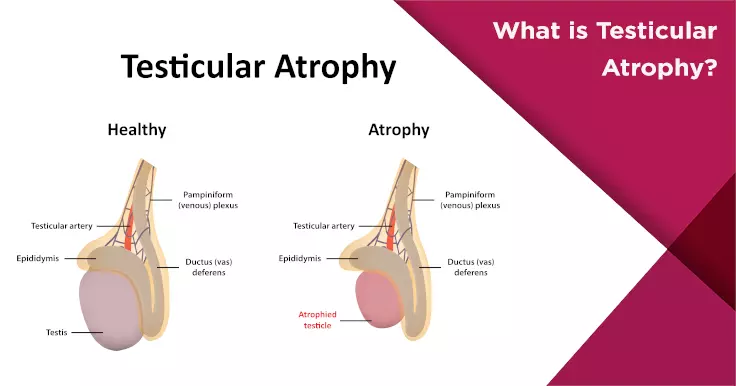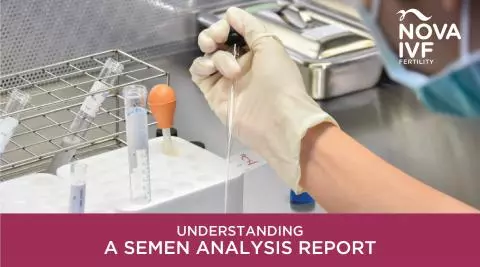Testicular Atrophy

Testicles are one of the most important components of the male reproductive system. They serve an important function of producing sperm and testosterone. The testicles play a vital role in the sexual development of a male when they reach puberty. The size and shape of the testicles also plays an important influence on the fertility of a man.
Testicular atrophy, a medical condition related to your reproductive system, can severely impact your fertility. This is usually a symptom of an underlying disease that can lead to irreversible shrinkage of the testicles. This article explores the testicular atrophy’s cause, symptoms, treatment options, and more. Keep reading to learn more about this condition.
What Is Testicular Atrophy?
The shrinking of testicles because of an infection, alcohol abuse, or the use of steroids is referred to as testicular atrophy. The testicles or testes are two male reproductive glands inside the scrotum that are responsible for the production of sperm and sex hormones.
It is a medical condition that is caused due to a loss of some Leydig cells and germ cells and can affect any male. The germ cells produce sperms and Leydig cells create testosterone. The shrinkage of testicles leads to a decrease in sperm count and/or testosterone levels.
Aging, infections, are underlying medical disorders are some of the causes of testicular atrophy. Many people confuse testicular atrophy with the natural shrinkage and expansion of the scrotum as a result of exposure to heat or cold. Testicular atrophy is not the same as this and requires medical attention for diagnosis and treatment.
What Are the Symptoms of Testicular Atrophy?
A visible shrink in the size of testicles is the most prominent symptom of this condition. If it affects boys before puberty, additional symptoms include absence of secondary sexual characteristics such as facial hair, pubic hair and increase in penile size. On the other hand, if it affects boys who have already gone through puberty, it can cause decreased libido, infertility, reduced muscle mass, absent or reduced facial hair growth and pubic hair growth, and make testicles feel softer than normal.
If the shrinkage of testicles is caused by an underlying condition, the affected male may also experience fever, nausea, inflammation, and pain in the testicles as symptoms of testicular atrophy.
When to See a Doctor?
Here are some of the warning signs that warrant a doctor’s visit immediately:
Significant Shrinkage of Testicles
Shrinkage of testicles is the most evident sign of testicular atrophy. Thus, as soon as you notice any significant shrinkage in your testicles, you ought to visit the doctor to get it checked.
Since testicular atrophy can impact your fertility, visiting a skilled andrologist, like the doctors at Nova IVF Fertility becomes imperative in family planning.
Discomfort/Pain in the Testicles
Although all causes of testicular atrophy don’t cause pain, experiencing pain along with testicular shrinkage can be a sign of an infection. You ought to seek urgent medical attention in such cases.
Sexual Dysfunction
If you are experiencing any signs of sexual dysfunction, such as low libido, erectile dysfunction, or trouble in orgasming, you are advised to visit an andrologist and get yourself checked. Testicular atrophy can lead to irreversible infertility in severe cases.
Lumps in the Testicles
If you have noticed that your testicles appear to have masses or lumps inside them, you must visit the doctor immediately and get screening tests done for testicular cancer.
If you notice a minor change in the size of your testicles and other symptoms like excessive fatigue, feeling low, or unexplained muscle loss, it is best to consult a doctor and get yourself checked for testicular atrophy or other possible causes.
What Are the Causes of Testicular Atrophy?
Here is a list of plausible causes of testicular atrophy:
Age
The risk of testicular atrophy also increases with age. This is because as the age of a man increases, his testosterone levels start to decrease after his peak reproductive years.
Orchitis
This condition is usually the result of an inflammation of the testicles or orchitis. Orchitis triggered by viral infections like Mumps is known as viral orchitis, while orchitis triggered by a sexually transmitted disease is usually known as bacterial orchitis.
- Hormone Imbalance
In some cases, testicular atrophy can also be caused by hormonal imbalance if the body produces less testosterone than usual. Testosterone replacement therapy (TRT) and the use of oestrogen, anabolic steroids, and certain medications can cause hormonal imbalance that may lead to the shrinking of testicles
Excessive Alcohol Usage
Excessive alcohol consumption regularly can lead to a decline in testosterone levels in the body and cause testicular tissue damage, which may lead to testicular atrophy.
Testicular Torsion
Testicular torsion occurs when a testicle rotates and the spermatic cords (cords that connect the testicles to the reproductive tract) are twisted. This condition causes swelling and pain in the testicles in addition to reduce blood flow to the testicles. If left untreated, testicular torsion can lead to permanent testicular atrophy.
Testicular Cancer
Testicular atrophy can also be caused by testicular cancer in rare cases. Testicular cancer usually affects younger men more than older men, but it is highly treatable.
Varicocele
In this condition, the veins in the scrotum become enlarged. Usually, varicocele occurs in the left testicle only. Many people who have varicocele often don’t realise that they have this condition as there may be no noticeable symptoms. However, if you pay attention, you may be able to observe that the left testicle appears smaller.
Infectious Diseases
Infectious diseases, such as mumps and human immunodeficiency virus (HIV), can cause testicular atrophy. The reversal of testicular atrophy is dependent on the severity of the infection and the treatment used.
How Is Testicular Atrophy Diagnosed?
An andrologist or urologist can help with the diagnosis of testicular atrophy. The doctor will conduct a physical examination of the testicles and observe the size, shape, texture, and firmness of the testicles to diagnose testicular atrophy. They will likely ask questions about the symptoms, starting date of the symptoms, person’s lifestyle, medical history of the person, and current medication.
If needed, the doctor may also recommend some diagnostic test, such as the ones mentioned below, to figure out the cause of the condition:
- Ultrasound of testicles to observe blood flow and detect possible abnormalities
- Blood tests to rule out infections
- Urine test or swabs to test for sexually transmitted infections (STIs)
- Blood test to check hormonal imbalance
What Is the Treatment of Testicular Atrophy?
Testicular atrophy can be treated. If diagnosed early enough, it can be easily reversed. However, if it is left till a later stage, it may not be reversible. Treatment depends largely on the factors triggering the atrophy. Hence, it is important to consult a doctor as soon as you notice symptoms of testicular atrophy, confirm the diagnosis, and start the treatment.
In some cases, making a few lifestyle changes may be enough to treat the testicular atrophy. If it is caused by a sexually transmitted infection, antibiotic therapy may be required.
Possible treatment options for testicular atrophy include the following:
Antibiotics
This line of treatment works best in case of testicular atrophy caused by an infection or STIs.
Hormone Replacement Therapy (HRT)
Hormone replacement therapy (HRT) with is a management strategy, especially for those people who have testicular atrophy due to low testosterone levels. This strategy helps in increasing the total testosterone levels in the body and bring them to an optimum level.
Surgery
Surgery is usually not the most preferred form of treatment for testicular atrophy; but it is recommended when the shrinkage of your testicles is caused by testicular torsion.
Lifestyle Changes
Some lifestyle changes such as quitting smoking and limiting alcohol intake are recommend preventing further damage to the testicles and treat the shrinkage of your testicles.
Although some people claim that natural treatment methods, like ayurveda, can cure testicular atrophy. However, there is not enough clinical date to support this claim. As of yet, there is no proven way to naturally reverse the shrinkage of your testicles; waiting for even a few hours can prove to be detrimental for recovery.
What Are the Risks of Testicular Atrophy?
Testicular atrophy is a risk factor for some of the common diseases related to male infertility. Here is a list of some risks of testicular atrophy:
- Erectile Dysfunction
Erectile dysfunction or ED is one of the common implications of testicular atrophy that is a result of low testosterone levels in the body. The deficiency of this hormone is the cause behind erectile dysfunction due to testicular atrophy.
Infertility
As you are now aware, testicular atrophy can cause a significant drop in the body’s testosterone production in addition to lowering sperm production in the testicles. If a male has testicular atrophy in both their testicles (also called bilateral atrophy), it can severely impact sperm production and testosterone levels in the body, which can lead to infertility.
Psychological Problems
A lack of confidence and increased levels of stress is common in people with testicular atrophy. If you have testicular atrophy, you must visit a skilled andrologist to get your testicles checked.
Testicular Cancer
Testicular cancer is another risk of testicular atrophy, and people who are affected this condition are recommended to get regular screening for testicular cancer.
Why Visit Nova IVF Fertility for Testicular Atrophy?
A leading fertility clinic in India, Nova IVF Fertility specialises in helping people realise their dreams of building a family. One of the most prominent after-effects of testicular atrophy is infertility, which can prove to be detrimental for a person’s overall quality of life.
If you have testicular atrophy and wish to preserve your fertility, it is best to consult male fertility specialists from our team of experienced doctors. Here is a list of some of the benefits you can enjoy upon visiting your nearest Nova IVF Fertility centre:
- Access to highly experienced male fertility experts
- Transparent communication about possible treatment options and cost of treatment
- Support during the procedure
- Access to advanced fertility treatment options, such as intracytoplasmic morphological-selected sperm injection (IMSI), in addition to in vitro fertilisation (IVF)
- Unbiased medical opinion to ensure your safety and well-being through the process of consultation, diagnosis, and treatment
- Option to freeze healthy sperms
- State-of-the-art technology to ensure best care for all patients
- Focused care and support throughout the treatment journey
Conclusion
There are numerous factors that can lead to testicular atrophy, from viral infections to the use of steroids. To avoid the possibility of permanent damage to your reproductive system, you are advised to regularly check for the size and shape of your testicles. In case one or both of your testicles suddenly appear smaller, it is best to get them checked by an andrologist or a urologist. This is because damage from testicular atrophy can be reversed to some extent with early medical intervention.
FAQs About Testicular Atrophy
Q. What is the normal size of the testicles?
A. The normal size of a male’s testicles can vary from another. But in general, normal testicles are about 4-5 cm in length, about 3 cm in height and about 2 cm in width. Additionally, the average volume of an adult male testicle is about 18 mL.
Q. Can I have children if I have been diagnosed with testicular atrophy?
A. Yes, if you have testicular atrophy in only one testicle and the other is normal, you can conceive children.
Q. Is erectile dysfunction a side effect of testicular atrophy?
A. Yes. Erectile dysfunction can be caused by testicular atrophy as it leads to a reduced production of testosterone (one of the male sex hormones) in the body. However, this is not the case if only one of your testicles is atrophic. Testicular atrophy also impacts the psychology of the affected male, and thus, it may lead to erectile dysfunction.
Q. What is the cause of testicular atrophy?
A. Testicular atrophy can be caused by a variety of factors, including infections, hormonal imbalance, advancing age, and conditions like varicocele. Read the article to know more about the possible causes of this condition.
 Infertility Counselling
Infertility Counselling Female Infertility Treatment
Female Infertility Treatment Andrology Treatment
Andrology Treatment Fertility Enhancing Surgeries - Female
Fertility Enhancing Surgeries - Female Fertility Enhancing Surgeries - Male
Fertility Enhancing Surgeries - Male Endoscopy Treatment
Endoscopy Treatment IUI Treatment
IUI Treatment IVF Treatment
IVF Treatment ICSI Treatment
ICSI Treatment Advanced IVF Solutions
Advanced IVF Solutions Embryology
Embryology Vitrification Egg, Embryo, Sperm Freezing
Vitrification Egg, Embryo, Sperm Freezing Preimplantation Genetic Testing (PGT)
Preimplantation Genetic Testing (PGT) Donation Program Embryo / Egg / Sperm
Donation Program Embryo / Egg / Sperm Self-cycleTM IVF
Self-cycleTM IVF

 Self-cycleTM IVF
Self-cycleTM IVF










